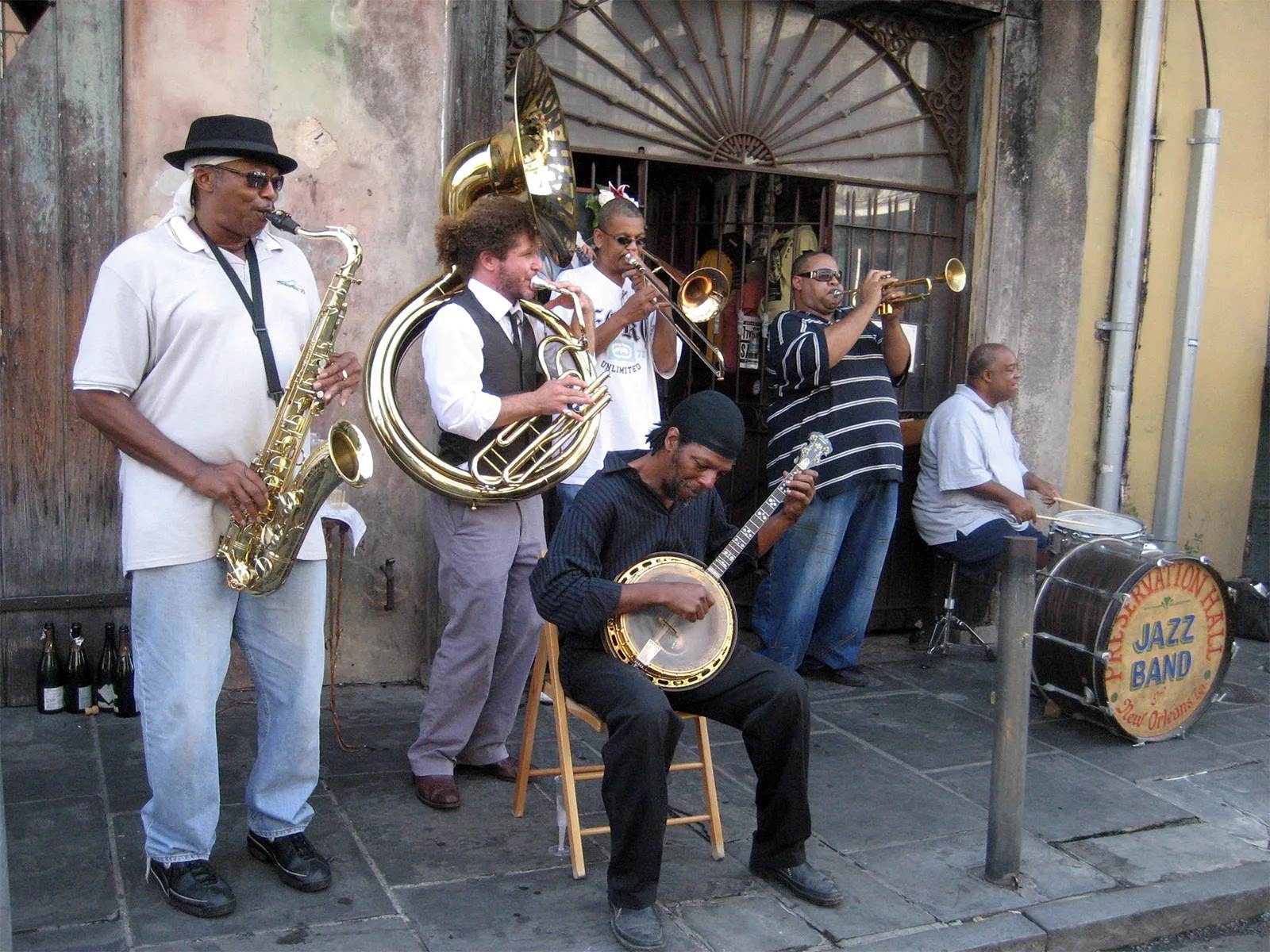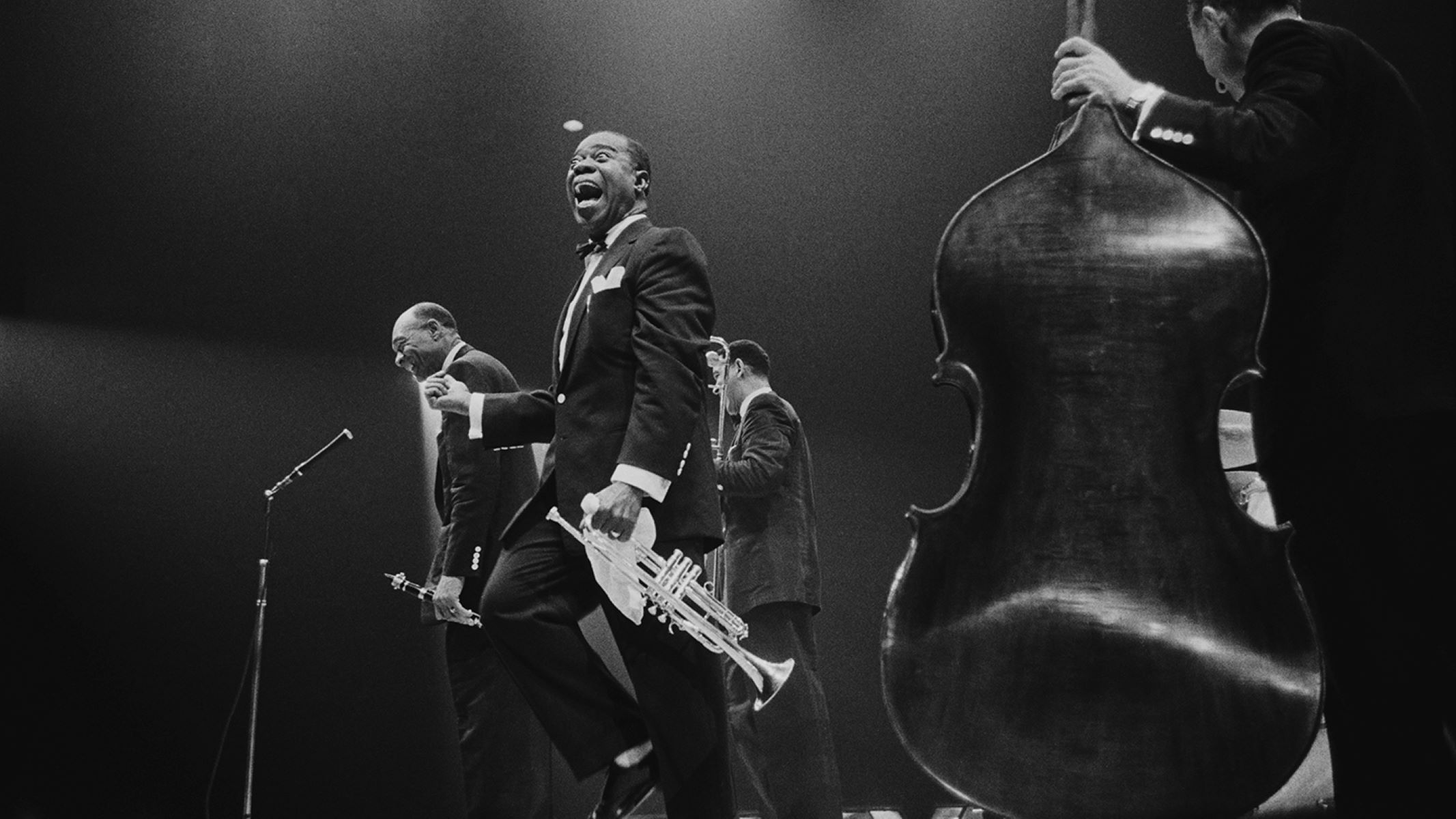

Jazz
What Is A Jazz Band
Modified: February 24, 2024
Discover the essence of jazz with our talented jazz band. Immerse yourself in soulful melodies and energetic rhythms that will transport you to the world of jazz.
(Many of the links in this article redirect to a specific reviewed product. Your purchase of these products through affiliate links helps to generate commission for AudioLover.com, at no extra cost. Learn more)
Table of Contents
Introduction
When you think of Jazz, your mind may immediately conjure up images of smoky clubs, stylish musicians, and toe-tapping rhythms. Jazz is a vibrant and improvisational genre of music that originated in the African American communities in the late 19th and early 20th centuries. It has since evolved into a global phenomenon that has captivated audiences and inspired countless musicians.
At the heart of the Jazz movement is the Jazz band, a collective of talented individuals who come together to create pulsating harmonies, intricate melodies, and spirited solos. In this article, we will delve into the world of Jazz bands, exploring their foundations, instruments, roles and responsibilities, styles and subgenres, as well as notable bands and musicians who have shaped the genre.
Whether you are a Jazz enthusiast or simply curious about this captivating genre, join us on this musical journey as we unravel the magic of Jazz bands.
Definition of a Jazz Band
A Jazz band is a musical ensemble that specializes in performing Jazz music. It is characterized by its improvisational nature, syncopated rhythms, and complex harmonies. Unlike traditional orchestras or rock bands, Jazz bands often have a fluid lineup, allowing for spontaneous musical interactions and a dynamic sound.
One of the defining features of a Jazz band is its emphasis on improvisation. Jazz musicians are skilled in the art of creating music on the spot, reacting to the musical ideas of their fellow bandmates. This improvisational element adds a sense of spontaneity and creativity to the performance, making each rendition of a song unique and thrilling.
Jazz bands typically consist of a combination of instruments, such as brass instruments (trumpet, trombone), woodwind instruments (saxophone, clarinet), piano, bass, drums, and guitar. The specific instrumentation can vary depending on the style and era of Jazz being performed. Some larger ensembles may include additional instruments like vibraphones, organs, or even vocalists.
While the term “Jazz band” is often used broadly, there are different types of Jazz bands that specialize in specific subgenres or eras of Jazz. Some examples include big bands, small combos, Dixieland bands, swing bands, and bebop groups. Each type of Jazz band has its own unique sound, instrumentation, and playing style, contributing to the rich tapestry of Jazz music.
Whether it’s the high-energy performances of a big band or the intimate interplay of a small combo, Jazz bands are known for their dynamic and captivating live shows. The interaction between band members, the improvisation, and the sheer talent on display make Jazz bands a true marvel to behold.
History of Jazz Bands
The history of Jazz bands can be traced back to the late 19th century in the African American communities of New Orleans, Louisiana. It emerged as a fusion of African and European musical traditions, blending elements of ragtime, blues, march music, and spirituals.
During the early years, Jazz bands were predominantly made up of brass instruments, such as trumpets, trombones, and tubas, accompanied by the rhythmic support of instruments like drums and banjos. This style of Jazz, known as Dixieland, gained popularity in the early 20th century and featured lively group improvisation and an infectious energy that got the audiences moving.
As Jazz music spread across the United States, so too did the diversity of Jazz bands. In the 1920s, the era of the Roaring Twenties, Jazz bands expanded in size and complexity, giving rise to the phenomenon of big bands. These larger ensembles featured sections of brass instruments, woodwind instruments, a rhythm section, and often included vocalists. Big bands became synonymous with the Swing Era, with iconic bandleaders like Duke Ellington, Count Basie, and Benny Goodman leading the way.
The 1940s marked a turning point in the history of Jazz bands with the emergence of bebop. Bebop was a radical departure from the popular Swing sound, emphasizing fast tempos, intricate melodies, and complex harmonic progressions. Small combos consisting of a rhythm section and a handful of virtuosic soloists became the norm in this era, with iconic figures like Charlie Parker and Dizzy Gillespie pushing the boundaries of Jazz music.
In the decades that followed, Jazz bands continued to evolve and adapt to new musical trends. The 1950s saw the rise of cool Jazz, characterized by a more laid-back sound and experimental arrangements. The 1960s brought about the avant-garde movement, introducing free Jazz and unconventional approaches to improvisation.
Today, Jazz bands continue to thrive around the world, with diverse styles and interpretations of the genre. From traditionalists who faithfully preserve the sounds of early Jazz to modern fusion bands that blend Jazz with other genres like rock, Latin, and funk, the legacy of Jazz bands lives on.
The history of Jazz bands is a testament to the creativity, innovation, and cultural impact of this remarkable musical genre. Through the decades, Jazz bands have pushed boundaries, broken conventions, and captivated audiences with their sheer virtuosity and irresistible rhythms.
Instruments in a Jazz Band
Jazz bands are known for their diverse array of instruments, each playing a crucial role in creating the distinct sound and atmosphere of the music. From the brass section to the rhythm instruments, let’s explore the key instruments typically found in a Jazz band:
- Brass Instruments: Trumpet, trombone, and saxophone are the backbone of the brass section in a Jazz band. The trumpet is responsible for playing vibrant melodies and dynamic solos, while the trombone adds rich harmonies and smooth glissandos. The saxophone, available in various sizes such as alto, tenor, and baritone, fills the ensemble with its warm and expressive tones.
- Woodwind Instruments: Besides the saxophone, woodwind instruments such as clarinet and flute also find their place in Jazz bands. The clarinet adds a unique timbre, often associated with Dixieland and traditional Jazz styles. The flute brings a delicate and ethereal quality to the ensemble.
- Piano: The piano serves as the primary harmonic instrument in a Jazz band. Pianists master the art of comping, providing chordal accompaniment and rhythmic support while also taking captivating solos. The piano’s rich tonal range makes it a versatile and essential component of Jazz bands.
- Bass: The bass, whether acoustic or electric, is responsible for providing the foundation and driving the rhythm of the music. Jazz bassists are known for their intricate walking bass lines, improvisational skills, and maintaining a steady groove throughout the performance.
- Drums: The drums play a vital role in setting the tempo, supplying rhythmic variations, and driving the energy of the music. Jazz drummers use a variety of techniques, including cymbal crashes, snare drum accents, and improvised fills to add excitement to the performance.
- Guitar: While not as common as other instruments, the guitar finds its place in some Jazz bands, particularly in smaller ensembles. Jazz guitarists employ both rhythm and lead playing techniques, comping chords, and delivering melodic solos with their instrument.
These instruments work together in harmony, each performer contributing their unique voice to create the intricate textures and captivating improvisations that are characteristic of Jazz music. The interaction between the instruments and the musicians’ ability to listen and respond to one another is what sets Jazz bands apart and makes their performances so dynamic and engaging.
Roles and Responsibilities in a Jazz Band
A Jazz band is not just a collection of individual musicians but a cohesive unit where each member has a specific role and responsibility. Let’s explore the key roles within a Jazz band:
- Bandleader: The bandleader is often an instrumentalist who serves as the focal point of the ensemble. They provide musical direction, choose the repertoire, and lead the band during performances. The bandleader sets the overall vision and aesthetic of the band, while also ensuring that the individual musicians have opportunities to shine through solos and improvisations.
- Soloists: Jazz music is renowned for its emphasis on individual expression and improvisation. Soloists take center stage during performances, showcasing their instrumental prowess and creativity. They take turns to improvise melodies and solos over the chord progressions, creating unique musical phrases that captivate the audience.
- Rhythm Section: The rhythm section forms the backbone of the band, providing the harmonic and rhythmic foundation for the music. This section typically consists of the piano, bass, and drums. The pianist lays down the chords and rhythmically supports the band, while the bassist and drummer work together to create a solid groove and maintain the tempo. The rhythm section is responsible for propelling the band forward and maintaining the overall dynamic feel of the music.
- Supporting Instruments: Instruments like trumpet, trombone, saxophone, and other members of the band provide supporting roles. They alternate between playing melodies, harmonies, and backing up the soloists. These musicians add depth and texture to the overall sound, weaving their parts seamlessly with the rhythm section.
- Arranger: In larger ensembles, an arranger may be responsible for crafting musical arrangements specifically for the Jazz band. They orchestrate the various parts, blending the different instruments to create a cohesive and harmonically rich sound. The arranger also ensures that there is balance and clarity in the musical presentation.
- Improvisers: Improvisation is a defining element of Jazz music, and all members of a Jazz band are expected to have the ability to improvise to varying degrees. Whether it’s the soloists taking extended solos or the rhythm section comping and creating improvised accompaniments, the band members must be adept at thinking on their feet and spontaneously creating musical ideas.
Within a Jazz band, the roles and responsibilities may overlap and evolve depending on the musical situation and individual band dynamics. Each member contributes their unique skills, creativity, and interpretation, resulting in a symbiotic relationship that brings the music to life.
Successful Jazz bands are characterized by their ability to listen to one another, respond in the moment, and create a cohesive musical experience. The interplay between the different roles and the seamless integration of individual contributions are what make Jazz band performances so captivating and memorable.
Jazz Band Styles and Subgenres
Jazz is a genre that has evolved and diversified over time, giving rise to various styles and subgenres. Each style possesses its own unique characteristics, instrumentation, and playing techniques. Let’s explore some of the prominent Jazz band styles and subgenres:
- Dixieland: Also known as Traditional Jazz, Dixieland is one of the earliest Jazz styles. It emerged in New Orleans in the early 20th century and features lively collective improvisation. Dixieland bands typically include trumpet, trombone, clarinet, piano, bass, and drums, creating a vibrant and energetic sound.
- Swing: The Swing Era of the 1930s and 1940s introduced a big band sound characterized by its infectious rhythms and danceable tunes. Swing bands comprise a larger ensemble with sections of brass, woodwind instruments, and a rhythm section. The Swing style includes iconic bandleaders like Duke Ellington, Count Basie, and Benny Goodman.
- Bebop: Bebop emerged in the 1940s as a response to the constraints of commercial Swing music. It features fast tempos, complex harmonies, and virtuosic instrumental solos. Bebop bands are typically smaller combos with a rhythm section and a few soloists. The style was popularized by musicians such as Charlie Parker, Dizzy Gillespie, and Thelonious Monk.
- Cool Jazz: Cool Jazz emerged in the 1950s as a more relaxed and understated response to the energy of Bebop. It incorporates elements of classical music, featuring intricate arrangements and a refined approach to improvisation. Cool Jazz bands often include trumpet, saxophone, trombone, piano, bass, and drums.
- Latin Jazz: Latin Jazz combines elements of Jazz with Afro-Cuban and Latin American rhythms. It fuses the syncopated rhythms and improvisational nature of Jazz with the infectious grooves of Latin music. Latin Jazz bands incorporate a wide range of instruments, including brass, woodwinds, percussion, and Latin American percussion instruments like congas and bongos.
- Fusion: Jazz Fusion emerged in the late 1960s and integrates elements of Jazz with other genres like rock, funk, and R&B. Fusion bands often feature electric instruments, synthesizers, and elaborate arrangements. Notable Fusion musicians and bands include Miles Davis, Herbie Hancock, and Weather Report.
These are just a few examples of the many styles and subgenres within the world of Jazz. Each style has its own distinct sound, instrumentation, and improvisational approach, reflecting the diverse influences and creative evolution of Jazz music over the years.
Exploring different Jazz band styles and subgenres allows us to appreciate the vast spectrum of musical expression that Jazz offers. From the jubilant Dixieland bands to the complex and daring sounds of Fusion, each style contributes to the richness and progression of Jazz as a timeless art form.
Famous Jazz Bands and Musicians
Jazz has been home to a plethora of exceptional bands and musicians whose talents have left an indelible mark on the genre. These artists have pushed the boundaries of musical innovation, captivated audiences, and influenced generations of musicians. Let’s take a look at some of the most influential and renowned Jazz bands and musicians:
- Louis Armstrong: Louis Armstrong, affectionately known as Satchmo, was a legendary trumpeter and vocalist whose gravelly voice and virtuosic playing style made him an icon of Jazz. His innovative improvisations, charismatic stage presence, and timeless hits like “What a Wonderful World” continue to inspire and move audiences around the world.
- Duke Ellington and His Orchestra: Duke Ellington, a prolific composer, and bandleader, led one of the greatest Jazz bands of all time, His Orchestra. Known for their rich harmonies and distinctive sound, the band’s performances and compositions introduced a level of sophistication and elegance to the Swing Era. Classics like “Take the A Train” and “Mood Indigo” are synonymous with Ellington’s immense musical legacy.
- Miles Davis: Miles Davis was an influential trumpeter, bandleader, and composer who played a significant role in the development of several Jazz styles, including cool Jazz and Jazz Fusion. His album “Kind of Blue” is widely regarded as one of the greatest Jazz recordings of all time, exemplifying his talent for creating atmospheric and evocative musical landscapes.
- John Coltrane: John Coltrane, a pioneering saxophonist, and composer, revolutionized Jazz with his groundbreaking improvisations and innovative approaches to harmony and structure. Coltrane’s albums like “Giant Steps” and “A Love Supreme” pushed the boundaries of Jazz and continue to inspire musicians seeking artistic exploration and expression.
- Ella Fitzgerald: Known as the “First Lady of Song,” Ella Fitzgerald possessed a stunning vocal range and impeccable sense of phrasing. Her unparalleled scatting ability and interpretations of popular songs have mesmerized audiences for decades. Fitzgerald’s collaborations with jazz luminaries like Duke Ellington and Louis Armstrong remain legendary.
- The Modern Jazz Quartet: The Modern Jazz Quartet (MJQ) was an influential group that showcased the intricate interplay and refined improvisations within a small ensemble setting. Their blend of Jazz, classical, and chamber music elements created a sophisticated and elegant sound. The MJQ’s unique approach and compositions made them a highly regarded group in the Jazz world.
These are just a handful of the countless Jazz bands and musicians who have shaped the genre’s rich history. Countless other artists, such as Charlie Parker, Billie Holiday, Thelonious Monk, and countless others, have contributed their extraordinary talents and creative genius to the world of Jazz.
These musicians have left a profound legacy, inspiring new generations to explore the possibilities of Jazz and continue its evolution. Their contributions to the art form have propelled Jazz into the mainstream and reinforced its status as a cherished and enduring genre of music.
The Evolution of Jazz Bands
Jazz bands have evolved significantly since their inception, adapting to new musical trends, incorporating diverse influences, and innovating within the genre. The evolution of Jazz bands can be traced through various eras and stylistic shifts, reflecting the changing times and the artistic visions of musicians. Let’s explore the key phases in the evolution of Jazz bands:
- Early Jazz and Dixieland: In the early 20th century, Jazz bands emerged in the African American communities of New Orleans. These bands, often referred to as Dixieland bands, featured brass instruments, such as trumpet and trombone, along with clarinet, piano, bass, and drums. The emphasis was on collective improvisation and lively rhythms.
- The Swing Era and Big Bands: The 1930s and 1940s brought forth the Swing Era, a period dominated by large Jazz orchestras known as big bands. Led by charismatic bandleaders like Duke Ellington and Count Basie, big bands featured sections of brass, woodwinds, piano, bass, and drums. These ensembles showcased elaborate arrangements, energetic rhythms, and infectious danceable tunes.
- The Bebop Revolution: In the 1940s, a new movement called Bebop emerged, rejecting the commercialism of Swing and emphasizing small combos and individual artistry. Bebop bands consisted of a rhythm section and a few soloists, typically trumpet, saxophone, piano, bass, and drums. The emphasis was on fast tempos, complex harmonies, and virtuosic improvisations.
- The Cool Jazz and Hard Bop Era: As the 1940s transitioned into the 1950s, Jazz went through a period of refinement and introspection. Cool Jazz, exemplified by artists like Miles Davis, showcased a more subdued and relaxed sound, with intricate arrangements and harmonically complex compositions. Hard Bop, on the other hand, represented a return to a more soulful and blues-infused style.
- Free Jazz and Avant-Garde: In the 1960s, Jazz witnessed a period of experimentation and boundary-pushing. Free Jazz, spearheaded by musicians like Ornette Coleman and John Coltrane, discarded traditional structures, embracing collective improvisation, and unconventional approaches to harmony and rhythm. Avant-Garde Jazz further pushed the boundaries, incorporating elements of free improvisation, free-form compositions, and experimental sounds.
- Fusion and Contemporary Jazz: From the late 1960s onwards, Jazz fused with other genres, giving rise to Fusion. Fusion bands incorporated elements of Rock, Funk, and R&B, combining electric instruments, synthesizers, and complex arrangements. The genre continues to evolve in contemporary Jazz, with artists blending traditional Jazz elements with modern influences, electronic sounds, and global musical traditions.
The evolution of Jazz bands reflects the ever-changing landscape of music and the continuous search for new sounds and artistic expression. Jazz bands have pushed boundaries, challenged conventions, and embraced innovation throughout its history, resulting in a genre that remains vibrant, diverse, and relevant to this day.
As Jazz continues to evolve, new styles and approaches emerge, ensuring that Jazz bands will continue to captivate audiences and push the boundaries of musical creativity for generations to come.
Conclusion
Jazz bands are at the heart and soul of the captivating world of Jazz music. From the early Dixieland bands to the larger-than-life big bands of the Swing Era, and the groundbreaking small ensembles of Bebop, Jazz bands have played a pivotal role in shaping this influential genre.
The rich tapestry of Jazz bands is characterized by their diverse instrumentation, improvisational spirit, and the dynamic interplay between band members. From the driving rhythm section to the expressive soloists, each member contributes their unique voice to create music that is both spontaneous and exhilarating.
Throughout history, Jazz bands have evolved, adapting to new musical trends and incorporating various influences. From the traditional sounds of Dixieland to the complex harmonies of Bebop, the refined elegance of Cool Jazz, and the boundary-pushing experimentation of Free Jazz and Fusion, Jazz bands have infused the genre with innovation and artistic growth.
The talent and creativity of renowned Jazz bands and musicians like Louis Armstrong, Duke Ellington, Miles Davis, and Ella Fitzgerald have left an indelible mark on the genre and inspired countless generations of musicians.
In conclusion, Jazz bands continue to be a testament to the power of collaboration, improvisation, and the joy of creating music in the moment. They have brought us timeless melodies, virtuosic solos, and unforgettable performances across a wide range of styles and subgenres.
As we appreciate the artistry and evolution of Jazz bands, let us also celebrate the diversity and innovation that defines this remarkable genre. With its ability to fuse cultures, break boundaries, and ignite passion, Jazz and its bands remain a powerful force in the musical landscape, captivating audiences around the globe.











